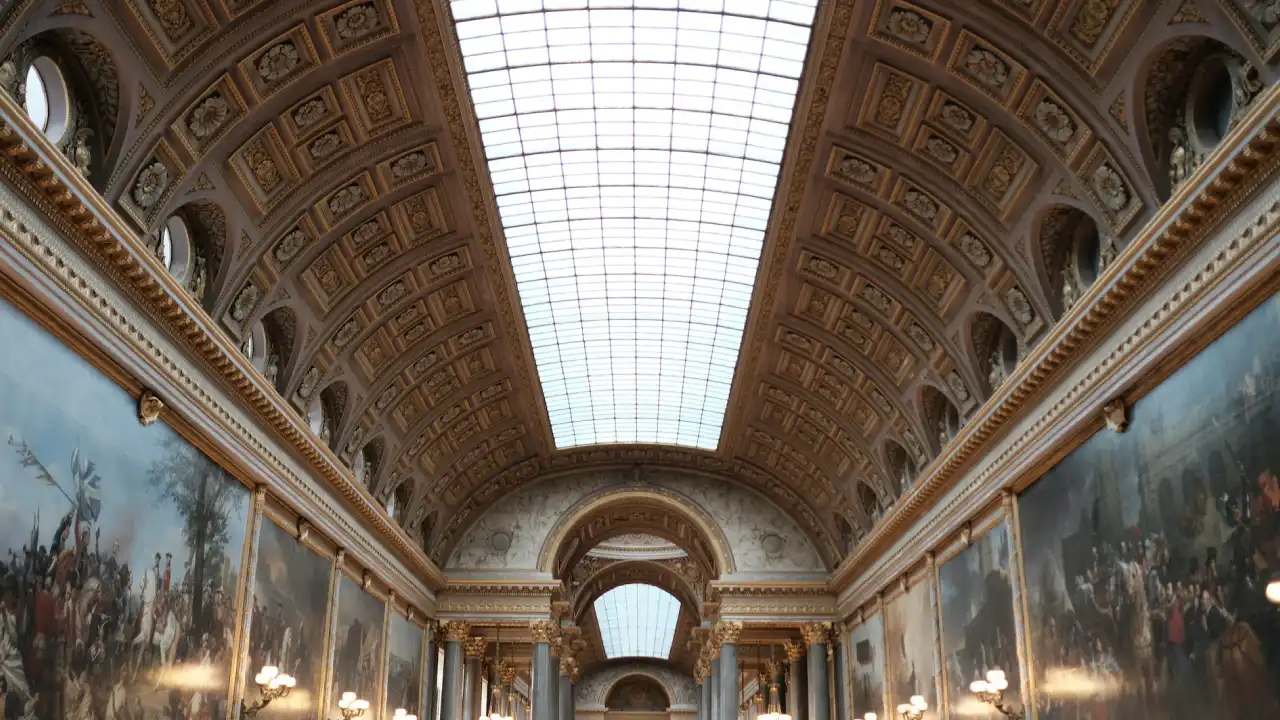Dive into the Palace of Versailles Collection, featuring masterpieces like “The Coronation of Napoleon.” Immerse yourself in art and history!

Customer support to help you with everything you need from 8.00 a.m. to 6.00 p.m.

Choose the best option for your needs and preferences and avoid the lines booking here

Enjoy art and history in Versailles, French monarchy’s masterpiece

The Palace of Versailles is not only a marvel of architecture and landscape design but also a treasure trove of art and historical artifacts. The extensive collection housed within the palace and its sprawling gardens provides a fascinating insight into the opulence and grandeur of the French monarchy. This article explores the notable works found at Versailles, including masterpieces of painting, intricate timepieces, and the expansive gardens that serve as a living museum.
The Palace of Versailles boasts a rich collection of artworks and historical objects that reflect the cultural and political history of France. These items are displayed throughout the palace and its grounds, each telling a unique story about the people and events that shaped the nation. Among the highlights of this collection are several remarkable pieces that stand out for their artistic and historical significance.
One of the most significant paintings in the Palace of Versailles is “La Consagración de Napoleón” (The Coronation of Napoleon) by Jacques-Louis David. This monumental work, measuring 6.21 meters by 9.79 meters, was commissioned by Napoleon himself to commemorate his coronation as Emperor of the French in 1804. The painting captures the grandeur of the event, depicting Napoleon crowning himself and his wife, Joséphine, in the presence of the Pope and other dignitaries.
David’s attention to detail and the use of dramatic lighting highlight the splendor and authority of Napoleon’s reign. The composition emphasizes the central figures of Napoleon and Joséphine, surrounded by
a meticulously rendered assembly of clergy, nobles, and officials. This painting is not only a masterpiece of neoclassical art but also a significant historical document that captures a pivotal moment in French history.
Another remarkable artifact in the Palace of Versailles is the Clock of the Count of Artois. This exquisite timepiece, crafted by the renowned clockmaker Jean-Simon Bourdier, is a stunning example of 18th-century French horology. The clock was created for Charles X, who held the title of the Count of Artois before becoming king.
The clock features intricate gilded bronze decorations, including mythological figures and elaborate scrollwork. The craftsmanship demonstrates the high level of skill and artistry that French clockmakers of the period possessed. This piece is not just a functional object but a work of art that embodies the elegance and sophistication of the French court.
The portrait of Marie Antoinette, Queen of France, by Élisabeth Vigée Le Brun, is one of the most iconic images in the Palace of Versailles. Painted in 1783, this portrait was intended to rehabilitate the queen’s public image amid growing unpopularity. Vigée Le Brun, a favored portraitist of the queen, depicted Marie Antoinette in a simple white muslin dress, known as a gaulle, which was a departure from the elaborate gowns typically worn by royalty.
The portrait portrays the queen with a serene and approachable demeanor, set against a naturalistic background that enhances her grace and elegance. This painting is significant not only for its artistic merit but also for its role in the propaganda efforts of the French monarchy during a tumultuous period.
The gardens of Versailles, designed by André Le Nôtre, are an integral part of the palace’s artistic heritage. Covering nearly 2,000 acres, the gardens are an open-air museum featuring a variety of sculptures, fountains, and meticulously landscaped lawns. Each element of the garden reflects the grandeur and meticulous planning that went into its creation.
The Apollo Fountain is one of the most famous features of the gardens. It depicts the Sun God Apollo riding his chariot, pulled by four horses, as he rises from the water. This sculpture symbolizes Louis XIV, the Sun King, and his association with the god Apollo. The fountain’s dynamic composition and intricate details make it a focal point of the garden, illustrating the connection between art, mythology, and royal propaganda.
The Grand Canal, a 1.5-kilometer-long waterway, is another prominent feature of the gardens. It serves as both a functional and aesthetic element, reflecting the surrounding landscape and enhancing the sense of scale and grandeur. The canal was used for boating parties and other court entertainments, further emphasizing the luxurious lifestyle of the French monarchy.
The Bosquet des Rocailles, or the Grove of the Rockeries, is one of the numerous groves in the gardens. Designed as outdoor rooms, these groves offer a variety of experiences, from intimate retreats to grand open spaces. The Bosquet des Rocailles features intricate rock formations and water features, creating a picturesque and serene environment that contrasts with the more formal parts of the garden.
Although primarily known for its architectural grandeur, the Hall of Mirrors (Galerie des Glaces) is also home to numerous artworks and historical artifacts. The hall itself is a masterpiece, with 357 mirrors reflecting the light from the windows overlooking the gardens. The ceiling, painted by Charles Le Brun, depicts scenes from the reign of Louis XIV, celebrating his military victories and achievements.
The hall’s opulent decor, including gilded sculptures and chandeliers, exemplifies the luxury and splendor of the French court. It was the setting for many significant events, including the signing of the Treaty of Versailles in 1919, which ended World War I.
The Royal Chapel of Versailles, completed in 1710, is an architectural and artistic gem within the palace. The chapel features a stunning vaulted ceiling painted by Antoine Coypel, depicting the Resurrection of Christ. The intricate woodwork, marble columns, and elaborate altar reflect the Baroque style’s emphasis on drama and grandeur.
The chapel was used for daily mass and important ceremonies, such as royal weddings and baptisms. Its design and decoration illustrate the close relationship between the French monarchy and the Catholic Church, as well as the importance of religious observance in court life.
The Battles Gallery (Galerie des Batailles) is a long hall adorned with large paintings depicting major military victories of France. Created during the reign of Louis-Philippe in the 19th century, this gallery serves as a celebration of French military history. The paintings, executed by various artists, cover a wide range of periods, from the early Middle Ages to the Napoleonic Wars.
The gallery’s design, with its high ceilings and extensive use of natural light, enhances the impact of the monumental canvases. This space underscores the role of Versailles as not only a royal residence but also a place of historical commemoration and national pride.
The Petit Trianon, a smaller chateau within the grounds of Versailles, was a personal retreat for Marie Antoinette. Designed by Ange-Jacques Gabriel, it exemplifies the neoclassical style with its clean lines and restrained decoration. The Petit Trianon offers a contrast to the opulence of the main palace, reflecting a more intimate and personal aspect of royal life.
Adjacent to the Petit Trianon is the Hameau de la Reine (the Queen’s Hamlet), a rustic retreat designed to resemble a village. Marie Antoinette used this space to escape the formality of court life and indulge in simpler, pastoral activities. The hamlet includes a farmhouse, a dairy, and a mill, all constructed with a charmingly idealized version of rural life in mind.
The Palace of Versailles is a repository of some of the most exquisite artworks and historical artifacts in the world. From grand paintings like “La Consagración de Napoleón” to the intricate Clock of the Count of Artois, and from the serene portrait of Marie Antoinette to the expansive open-air museum of the gardens, Versailles offers a rich tapestry of art and history.
Each piece within the palace and its grounds tells a story, offering a glimpse into the lives and times of the French monarchy. The careful preservation and display of these works ensure that the legacy of Versailles continues to inspire and educate visitors from around the globe. Whether you are an art enthusiast, a history buff, or simply a curious traveler, the treasures of Versailles provide a profound and enriching experience.
The location of Versailles was formerly a small community with a church. In order to hu…
Given that Versailles is associated with Louis XIV and vice versa, Louis XIV appears to…
Louis XV, sometimes referred to as Louis the Beloved was formerly known as the King of…
Louis XVI became king at a young age when he was just around twenty years old…
